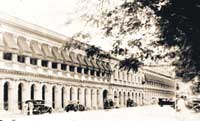First
signs of representative government
The month of October in the
year 1833 was a very significant one in the constitutional
history of our country. Particularly the first
of October that year was an important day in the
constitutional development of the country. That
was the day we saw the first signs of representative
and responsible government.
 |
| The Legislative Council
building in Queen's Street (now Janadhipathi
Mawata) in Fort was later used for the meetings
of the Senate. Presently it houses the Ministry
of Foreign Affairs. |
In 1829, Lieutenant-Colonel William
Colebrooke arrived in Ceylon having been appointed
by the British government to inquire into the
administration of the country. He was later joined
by Charles Cameron who was sent to report on the
judicial system. Following the recommendations
of the Colebrooke-Cameron Commission, it was decided
to set up an Executive Council and a Legislative
Council.
The Legislative Council was
formed to make laws and the Executive Council
was to see that the laws were carried out. The
latter consisted of the Governor and five of the
highest officials. They were the Colonial Secretary,
the Officer Commanding the Military Forces, the
Attorney General, the Auditor General and the
Treasurer. Its duties were advisory and the Governor,
though he consulted them, could disregard their
advice.
The Legislative Council had
nine official members besides the Governor, (these
included the five members of the Executive Council)
and six unofficial members. Those six members
were expected to speak and act on behalf of the
people. Three of them were to represent British
residents and the other three the Burghers, the
Sinhalese and the Tamils. All were to be appointed
by the Governor. All ordinances were to be introduced
by the Governor, who was the President of the
Council. The Council was no more than an advisory
body just like the Executive Council.
It was on October 1, 1833 that
both Councils met for the first time. The Governor
at the time was Sir Robert Horton. |
